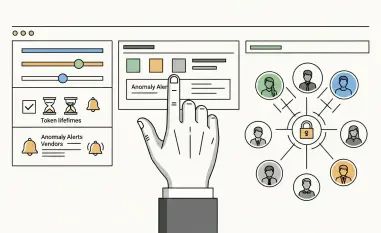Unveiling a Critical Cybersecurity Threat
Imagine a digital predator silently scanning the internet, targeting millions of devices with ruthless efficiency, from home routers to industrial systems, in a relentless quest to exploit vulnerabilities. This is the reality of a major cybersecurity menace that has emerged as a formidable challenge in the industry. Identified by leading security experts, this threat has rapidly escalated into a global concern, exploiting a staggering array of vulnerabilities across diverse systems. The scale of this issue underscores the fragility of internet-connected infrastructure in an era where digital dependency is at an all-time high.
The cybersecurity landscape in 2025 is under siege from increasingly sophisticated threats, with botnets leading the charge as tools of mass disruption. Among these, one particular botnet stands out for its aggressive tactics and expansive reach, affecting consumer, enterprise, and industrial environments alike. Its ability to target internet-exposed devices on a global scale has raised alarms across the sector, highlighting the urgent need for robust defense mechanisms.
This report delves into the intricacies of this cyber threat, examining its operational strategies, the breadth of its impact, and the systemic weaknesses it exploits. By shedding light on these critical aspects, the aim is to provide a comprehensive understanding of the challenges facing the industry and the steps needed to mitigate such risks. The focus remains on actionable insights for stakeholders navigating this evolving digital battleground.
Evolution and Tactics of the Botnet
From Targeted to Indiscriminate Attacks
The botnet in question was first detected on June 15 of this year, exploiting a specific flaw in a widely used router model. Within just a few months, by September, its scope had broadened dramatically, showcasing a shift from narrow, precise strikes to a sweeping, scattershot approach aimed at compromising as many devices as possible. This rapid transformation signals a dangerous adaptability that has caught the attention of security analysts worldwide.
A notable surge in activity occurred on September 22, as telemetry data revealed an unprecedented spike in exploitation attempts. This escalation points to a deliberate strategy to maximize impact, leveraging the botnet’s ability to adapt quickly to new environments. The sheer speed of this growth illustrates the pressing need for real-time monitoring and response mechanisms within the cybersecurity framework.
Central to this botnet’s operation is a loader-as-a-service model, which facilitates the distribution of malware across multiple architectures. This innovative approach allows for seamless integration with other malicious strains, enhancing its destructive potential. Such tactics reflect a growing trend in the industry where flexibility and scalability are becoming hallmarks of modern cyber threats.
Exploitation Techniques and Infrastructure
The operational framework of this botnet relies on a modular delivery system that exploits a range of technical flaws, including command injection and path traversal vulnerabilities. By gaining remote shell access to targeted devices, it establishes a foothold for further malicious activities. This method ensures that even diverse systems fall prey to its incursions with alarming ease.
Efficiency is further amplified through a rotating infrastructure that keeps its activities difficult to trace or predict. Automated tactics play a significant role in scaling operations, allowing the botnet to cast a wide net over potential victims. This reliance on automation is a stark reminder of how technology, while beneficial, can be weaponized against unsuspecting users.
Moreover, the integration of both known and potentially undiscovered exploits suggests continuous development by its creators. The use of N-day vulnerabilities alongside hints of zero-day flaws indicates a commitment to staying ahead of security patches and defenses. Such persistent innovation poses a formidable challenge to traditional cybersecurity measures, necessitating a proactive stance from the industry.
Scope of Vulnerabilities and Targeted Systems
The breadth of this botnet’s reach is evident in the 56 vulnerabilities it exploits, with 38 having officially assigned identifiers and 18 remaining unclassified, possibly pointing to undisclosed or novel flaws. This extensive arsenal targets a wide variety of internet-connected devices, exposing the pervasive nature of security gaps in digital ecosystems. The diversity of affected systems underscores a critical vulnerability in global infrastructure.
Devices such as routers, digital video recorders, network video recorders, CCTV setups, and web servers from prominent vendors are among the primary targets. Companies spanning a range of sectors, known for their widespread use in both home and business settings, find their products compromised by these attacks. Aging and often unpatched equipment remains a favored entry point, revealing a troubling trend of neglected maintenance in device security.
Specific vulnerabilities, including long-standing issues like the Shellshock flaw in software frameworks and multiple weaknesses in router systems, highlight the botnet’s strategy of exploiting persistent weak spots. These known issues, some dating back years, continue to plague unupdated devices, offering easy access to malicious actors. This situation emphasizes the critical importance of timely updates and lifecycle management in preventing such widespread breaches.
Systemic Challenges in IoT and Edge Device Security
The emergence of this botnet exposes deep-rooted issues in the security of Internet of Things (IoT) and edge devices, where fragmented approaches to protection are commonplace. Many of these devices lack consistent update mechanisms or suffer from inherent design flaws, leaving them exposed to exploitation. This systemic vulnerability is a glaring concern for an industry increasingly reliant on connected technologies.
A troubling trend is the transformation of vulnerabilities showcased in controlled research environments, such as hacking competitions, into real-world attack vectors. Flaws demonstrated under test conditions are quickly adapted by cybercriminals for malicious purposes, as seen with specific router vulnerabilities targeted by this botnet. This rapid weaponization of research findings calls for tighter controls and faster response strategies in the security community.
Patch management remains a significant hurdle, with many systems running outdated firmware due to user neglect or manufacturer oversight. The risks posed by such obsolete setups are compounded by the sheer volume of connected devices globally. Addressing these challenges requires a multifaceted approach, including enforced update cycles, network segmentation to limit breach impacts, and greater emphasis on secure-by-design principles in device manufacturing.
Future Implications and Emerging Threats
As of October this year, the botnet continues to expand its operational footprint, signaling a persistent challenge for cybersecurity professionals. Its growth trajectory suggests that without intervention, the scale of compromised systems could increase exponentially. This ongoing threat serves as a warning of the potential for even greater disruptions in the digital realm if left unchecked.
Looking ahead, the botnet’s arsenal of exploits is likely to grow, incorporating more sophisticated techniques and targeting an even broader range of devices. This potential for expansion reflects a larger pattern in cybercrime, where adaptability drives the success of malicious campaigns. Industry stakeholders must prepare for a landscape where threats evolve faster than defenses can be deployed.
Broader trends in botnet operations, such as heightened automation and scalability, point to a future where digital infrastructure faces relentless pressure. These developments underscore the interconnected nature of modern systems, where a single breach can ripple across networks globally. The implications for critical sectors, from finance to utilities, are profound, necessitating a unified effort to bolster resilience against such pervasive dangers.
Final Reflections and Path Forward
Looking back, the detailed examination of this botnet’s campaign revealed a complex interplay of advanced tactics and exploited systemic weaknesses that defined its impact throughout the year. The rapid shift from targeted to mass-scale attacks demonstrated a chilling adaptability, while the exploitation of numerous vulnerabilities exposed glaring gaps in device security. This analysis painted a sobering picture of an industry grappling with threats that outpace traditional countermeasures.
Reflecting on these findings, it became evident that the path forward demanded innovative solutions tailored to the evolving nature of cyber threats. A strategic focus on developing automated patch deployment systems could significantly reduce the window of vulnerability for many devices. Additionally, fostering collaboration between vendors and security researchers to preemptively address flaws before they are weaponized emerged as a vital step.
Ultimately, the journey ahead required a commitment to education and awareness, empowering end-users to adopt best practices like regular updates and device isolation. Exploring incentives for manufacturers to prioritize long-term support for their products offered another avenue to strengthen defenses. These actionable measures, combined with a proactive mindset, provided a roadmap to navigate the challenges posed by sophisticated cyber threats in an interconnected world.













